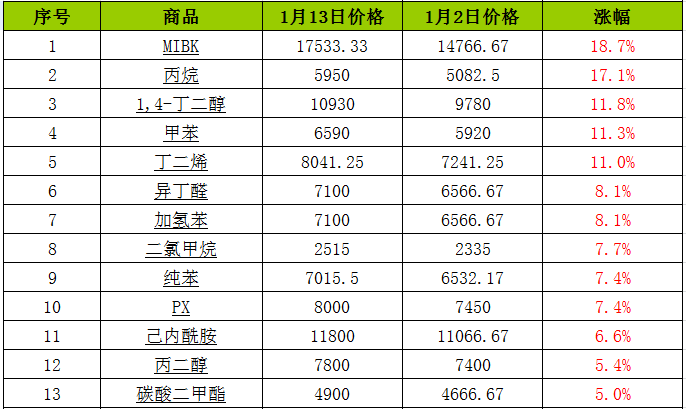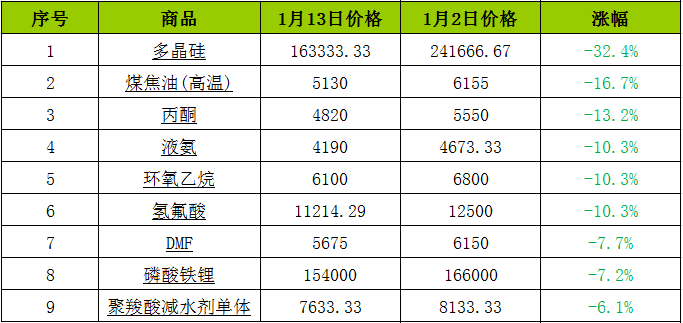In 2022, the international oil price rose sharply, the natural gas price in Europe and the United States rose sharply, the contradiction between coal supply and demand intensified, and the energy crisis intensified. With the repeated occurrence of domestic health events, the chemical market has entered a state of double pressure of supply and demand.
Entering 2023, opportunities and challenges coexist, from stimulating domestic demand through various policies to fully opening control
In the list of commodity prices in the first half of January 2023, there were 43 commodities in the chemical sector that rose on a month-on-month basis, including 5 commodities that rose more than 10%, accounting for 4.6% of the monitored commodities in the industry; The top three commodities were MIBK (18.7%), propane (17.1%), 1,4-butanediol (11.8%). There are 45 commodities with a month-on-month decline, and 6 commodities with a decline of more than 10%, accounting for 5.6% of the number of monitored commodities in this sector; The top three products in the decline were polysilicon (- 32.4%), coal tar (high temperature) (- 16.7%) and acetone (- 13.2%). The average rise and fall range was – 0.1%.
Increase list (increase more than 5%)

MIBK price increased by 18.7%
After the New Year’s Day, the MIBK market was affected by tight supply expectations. The national average price rose from 14766 yuan/ton on January 2 to 17533 yuan/ton on January 13.
1. The supply is expected to be tight, 50000 tons/year of large equipment will be shut down, and the domestic operating rate will drop from 80% to 40%. The short-term supply is expected to be tight, which is difficult to change.
2. After the New Year’s Day, the main downstream antioxidant industry replenishment, and downstream factories also replenishment after a period of small orders. As the holiday approaches, the downstream demand for small orders decreases, and the resistance to high-priced raw materials is obvious. With the supply of imported goods, the price gradually reached its peak and the rise slowed down.
Propane price increased by 17.1%
In 2023, the propane market started well, and the average price of Shandong propane market rose from 5082 yuan/ton on the 2nd to 5920 yuan/ton on the 14th, with the average price of 6000 yuan/ton on the 11th.
1. In the early stage, the price in the northern market was low, the downstream demand was relatively stable, and the enterprise effectively destocked. After the festival, the downstream began to replenish goods in stages, while the upstream inventory was low. At the same time, the recent arrival volume at the port is relatively low, the market supply is reduced, and the price of propane starts to rise strongly.
2. Some PDH resumed work and the demand for chemical industry increased significantly. With the support just needed, propane prices are easy to rise and difficult to fall. After the holiday, the price of propane rose, showing the phenomenon of strong in the north and weak in the south. In the early stage, the export arbitrage of low-end goods sources in the northern market effectively reduced inventory. Due to the high price, the goods in the southern market are not smooth, and the prices have been corrected one after another. As the holiday approaches, some factories enter the holiday mode, and migrant workers gradually return home.
1.4-Butanediol price increased by 11.8%
After the festival, the auction price of the industry rose sharply, and the price of 1.4-butanediol rose from 9780 yuan/ton on the 2nd to 10930 yuan/ton on the 13th.
1. The manufacturing enterprises are unwilling to sell the spot market. At the same time, the spot auction and high bidding transactions of the main factories promote the market focus to rise. In addition to the parking and maintenance of the first phase of Tokyo Biotech, the industry’s burden has declined slightly, and the manufacturing enterprises continue to deliver contract orders. BDO supply level is obviously favorable.
2. With the increase of restart load of BASF equipment in Shanghai, the demand of PTMEG industry has increased, while other downstream industries have little change, and the demand is slightly better. However, as the holiday approaches, some middle and lower reaches enter the holiday state in advance, and the overall market trading volume is limited.
Drop list (less than 5%)

Acetone fell by – 13.2%
The domestic acetone market fell sharply, and the price of East China factories dropped from 550 yuan/ton to 4820 yuan/ton.
1. The operating rate of acetone was close to 85%, and the port inventory rose to 32000 tons on the 9th, rising rapidly, and the supply pressure increased. Under the pressure of factory inventory, the holder has great enthusiasm for shipment. With the smooth production of Shenghong Refining and Chemical Phenol Ketone Plant, the supply pressure is expected to increase.
2. Downstream procurement of acetone is sluggish. Although the downstream MIBK market rose sharply, the demand was not enough to reduce the operating rate to a low point. Intermediary participation is low. They fell sharply when market transactions were ignored. With the decline of the market, the loss pressure of phenolic ketone enterprises increases. Most factories wait for the market to be clear before purchasing after the holiday. Under the pressure of profit, the market report stopped falling and rose. The market gradually became clear after the holiday.
Aftermarket analysis
From the perspective of upstream crude oil, the recent winter storm hit the United States, and crude oil is expected to have a low impact, and the cost support for petrochemical products will be weakened. In the long run, the oil market is not only faced with macro pressure and economic recession cycle constraints, but also faced with the game between supply and demand. On the supply side, there is a risk that Russia’s production will decline. OEPC+production reduction will support the bottom. In terms of demand, it is supported by macro-cycle inhibition, sluggish demand inhibition in Europe and demand growth in Asia. Affected by macro and micro long and short positions, the oil market is more likely to remain volatile.
From the perspective of consumers, domestic economic policies clearly adhere to the domestic big cycle and do a good job of international and domestic double cycle. In the post-epidemic era, it was fully liberalized, but the inevitable reality was that the entity was still weak and the wait-and-see mood intensified after the pain. In terms of terminals, domestic control policies have been optimized, and logistics and consumer confidence have been restored. However, short-term terminals need the off-season of the Spring Festival, and it may be difficult to have a significant turnaround in the recovery period.
In 2023, China’s economy will recover slowly, but in the face of the global economic downturn and the expected intensification of economic recession in Europe and the United States, China’s export market of bulk products will still face challenges. In 2023, chemical production capacity will continue to grow steadily. In the past year, the domestic chemical production capacity has increased steadily, with 80% of the main chemical products showing a growth trend and only 5% of the production capacity declining. In the future, driven by supporting equipment and profit chain, chemical production capacity will continue to expand, and market competition may further intensify. Enterprises that are difficult to form industrial chain advantages in the future will face profit or pressure, but will also eliminate backward production capacity. In 2023, more large and medium-sized enterprises will focus on the growth of downstream industries. With the continuous breakthroughs in domestic technology, environmental protection, high-end new materials, electrolytes and wind power industry chains are increasingly being valued by large enterprises. Under the background of double carbon, backward enterprises will be eliminated at an accelerated pace.
Post time: Jan-16-2023




